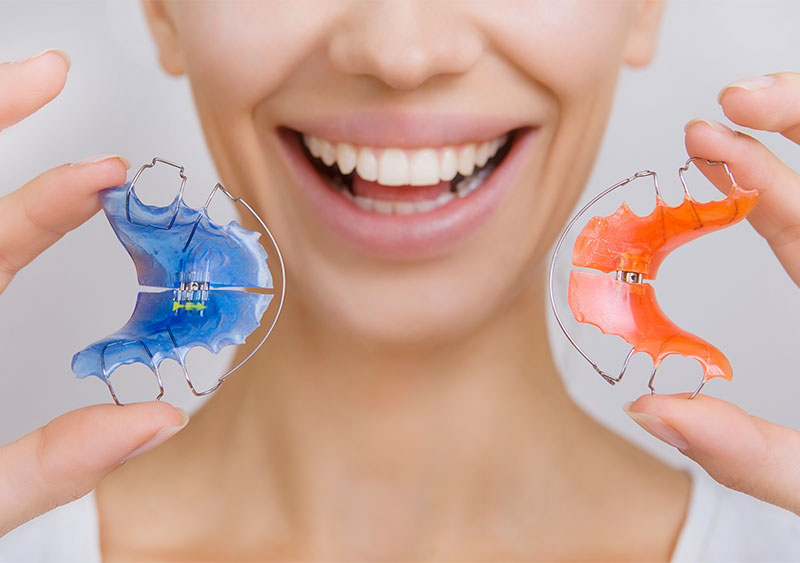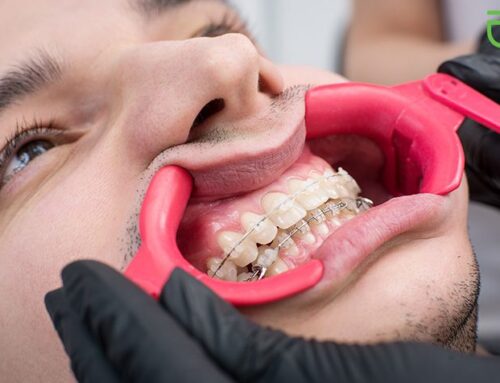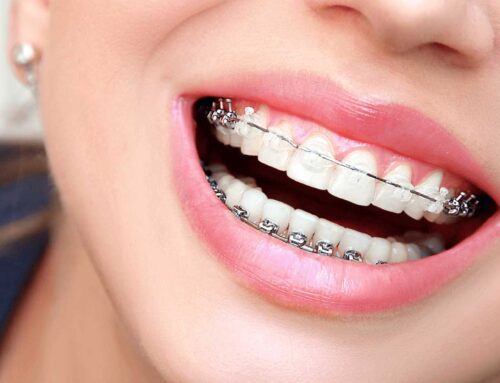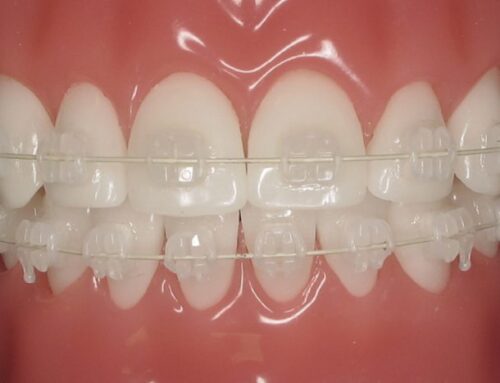Understanding How Retainers Work to Keep Teeth Straight after Braces Are Removed
Braces are very popular for patients of all ages who want straighter teeth, improved symmetry of their smiles, and to correct bite pattern problems that could lead to other dental health issues. However, it’s important for patients to know what to expect at the end of their orthodontic treatment, including why dentists may recommend that they continue to regularly wear a custom-fitted dental retainer after the braces come off.
There are many reasons why a person may need to get braces. Often, orthodontic treatment is necessary in order to fix issues related to misaligned teeth that could lead to more serious dental problems down the road. For example, crooked teeth may result in tooth grinding, difficulty in chewing and speaking, or increased likelihood in developing conditions such as tooth decay and gum disease. In other cases, braces are needed to create enough space for emerging teeth to come in properly and prevent overcrowding of teeth in the jaw. Of course, there are also many times where patients choose to undergo orthodontic treatment with the main goal of obtaining a better-looking smile.
Whatever the reason may be, it’s certain that the patient will want to make sure that their beautiful new smile stays in perfect condition long after the braces are removed. To do this, most patients who undergo orthodontics will be given a retainer at the conclusion of their treatment. Though, when their treatment is over, many patients wonder why retainers are necessary in the first place. The answer to this question is actually quite similar to how braces work to be able to move teeth into different positions. Let’s take a brief moment to review this process in order to add more context to the importance of retainers.
How Do Braces Work to Straighten Teeth?
In order to move teeth, a constant pressure is needed to gradually shift their position within the gums and jaw. This pressure is applied by the braces in a very precise pattern based on where the teeth need to move to. First, in the case of traditional metal braces, brackets are affixed directly to each of the teeth. Through each of these brackets runs a contiguous arch wire that is bent and shaped in a specific manner so that the orientation of the brackets will exert a constant pressure on each tooth and encourage it to move over time. This arch wire is held in place on the brackets by small elastic bands called ligatures.
At regular intervals the patient will return to the office for a checkup and to have the braces adjusted in order to continue the movement towards the desired final position. During these adjustment appointments, the ligatures will be removed, the arch wires will be replaced with new ones, and fresh ligatures will be put back on. Each time a new set of arch wires is put in place, the teeth will experience a new pressure pattern and will resume their progress towards the optimum positions in the jaw.
There are several types of braces that orthodontists have available to offer patients, depending on the preferences of the patient, and the degree of movement that is needed to achieve the desired results.
What Are the Different Kinds of Braces?
Traditional Metal Braces – These are the braces that you are probably most familiar with, as they are the most common type. As described earlier, these braces consist of metal brackets and bands affixed to each tooth, through which an arch wire runs, and is held in place by elastic ligatures. These ligatures can be virtually any colour imaginable, allowing the patients to choose colors that reflect their personality and preferences. They can choose from subtle shades like gray or clear, or bright and vibrant colours in any combination.
Ceramic Braces – Although very similar in design to metal braces, the materials used to make ceramic braces are quite different. Ceramic braces still consist of brackets, bands, arch wires, and ligatures just like metal braces, but are much more subtle in appearance. As their name suggests, ceramic braces are made of an advanced dental ceramic composite material. This material can be made in a variety of shades and colours, from subtle whites to blend in with the teeth, to translucent and transparent versions that are even less noticeable.
Fast Braces – When time is of the essence and the patient wants the shortest possible treatment times, fast braces are a very effective option. Visually, fast braces appear very much like traditional metal braces, but the design of the brackets is where the biggest difference can be found. Fast braces use a bracket that is specially engineered to exert pressure on the teeth in multiple directions at once. This means fewer adjustments are needed over the course of the treatment. Fast braces also incorporate subsonic wave therapy and phototherapy to improve the comfort of the patient and accelerate the movement of the teeth by stimulating the bone and soft tissues of the gums.
Invisalign Invisible Braces – Recent advancements in dental technology have introduced an innovative new method of performing orthodontic treatment in the form of the Invisalign system of invisible braces. Unlike other types of braces, the Invisalign system uses a series of custom-molded clear plastic aligners to exert pressure on the teeth instead of brackets or wires. At pre-determined intervals, the patient will simply start wearing the next set of aligners in order to continue the movement of the teeth. This offers many advantages to the patient, as they are generally considered to be more comfortable to wear, and can be easily removed and put back in place for greater convenience when eating and cleaning the teeth. Invisalign is very popular for these reasons, and due to the fact that because the plastic material is perfectly clear, they are virtually undetectable when worn.
What Happens When the Braces Come Off?
So, if all types of braces work through applying a constant pressure to the teeth, then when the braces are removed and the pressure is no longer there, the teeth should stay in place, right? In theory, yes. However, in actuality, there are always pressures being exerted on our teeth in one way or another. We’re usually just not aware of it. For example, when you are biting and chewing, there is pressure exerted on your teeth. Clenching the jaw, nighttime tooth grinding, and even speaking all put various levels of pressure on our teeth. This infrequent and irregular pressure has a cumulative effect, and can result in the slow shifting of teeth in the jaw.
For anyone who has just spent many months undergoing orthodontic treatment to get a beautiful smile, this gradual movement of the teeth is definitely not something you want to have happen. To stop this effect, there needs to be something to counteract the pressure and encourage the teeth to keep their positions. This is why a retainer is a very important part of orthodontics, and of your overall state of oral health.
How Do Retainers Prevent Teeth from Moving Out of Alignment?
At the end of your treatment timeline, once your braces have been removed, your dentist or orthodontist will likely schedule a follow-up appointment to have you fitted for a retainer. This custom-fitted dental appliance is designed to snugly fit on to the teeth and help them retain their current position, hence the name ‘retainer’. As the teeth experience the gentle pressures exerted through everyday activities like eating and speaking, the retainer works to counteract these pressures and prevent any gradual movement from occurring. It’s quite simple, really, but it’s also essential to remember that a retainer works best when worn frequently and consistently. This is when they will be most effective.
There are several different types of retainers, and depending on your unique case your dentist may be more likely to recommend one type over the others. Wire retainers are still used in many cases, and are very capable at keeping teeth in place, however their noticeable appearance when they are worn makes them less appealing to patients. Most patients these days will be given a clear plastic retainer that looks very similar to an Invisalign braces aligner, however the retainer is only designed to prevent tooth movement, not encourage it. These clear retainers are comfortable, virtually invisible, easy to remove, and easy to keep clean. In fact, most patients find them so comfortable that they often forget they are even wearing them!
For Straight Teeth and a Beautiful Smile That Never Goes Out of Style, Visit Georgian Dental
If you’ve been on the fence about getting braces, now is a great time to get started! There are many different styles of braces to choose from, and it’s never been easier or faster thanks to amazing advancements in orthodontic treatments. To learn more about your options and to start the process of getting a great looking smile and perfectly straight teeth, contact the team here at Georgian Dental to arrange for your no-obligation consultation. We’ll gladly answer any questions you may have, and clearly outline what you can expect when you get braces at our clinic. Call now, we’re looking forward to hearing from you!
Appointment Request
If you’re interested in any of our procedures, and would like to meet with one of our dentists to discuss options, costs and get additional information, complete this short form and we’ll give you a call to arrange for a no-obligation appointment at our Barrie clinic.










